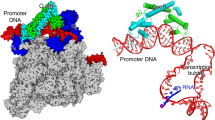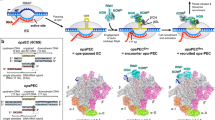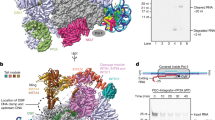Abstract
DNA helicases open the duplex during DNA replication, repair and transcription. However, RNA polymerase II is the only member of its family with this requirement; RNA polymerases I and III and bacterial RNA polymerases open DNA without a helicase. In this report, characterization of XPB mutants indicates that its helicase activity is not used for RNA polymerase II promoter opening, which is instead driven by its ATPase activity. The mutants have parallels in σ54 bacterial transcription and this suggests a similar mode of opening DNA for both RNA polymerases, involving ATP-dependent enzyme conformational changes. Promoter escape is defective in these XPB mutants, suggesting that the XPB helicase acts as an ATP-driven motor to reorganize the tightly wrapped multiprotein eukaryotic preinitiation complex during the remodeling that precedes elongation and the coupling to RNA processing events.
This is a preview of subscription content, access via your institution
Access options
Subscribe to this journal
Receive 12 print issues and online access
$209.00 per year
only $17.42 per issue
Buy this article
- Purchase on SpringerLink
- Instant access to full article PDF
Prices may be subject to local taxes which are calculated during checkout





Similar content being viewed by others
References
Egly, J.M. The 14th Datta Lecture. TFIIH: from transcription to clinic. FEBS Lett. 498, 124–128 (2001).
Mendez, J. & Stillman, B. Perpetuating the double helix: molecular machines at eukaryotic DNA replication origins. Bioessays 25, 1158–1167 (2003).
Moreland, R.J. et al. A role for the TFIIH XPB DNA helicase in promoter escape by RNA polymerase II. J. Biol. Chem. 274, 22127–22130 (1999).
Svejstrup, J.Q. The RNA polymerase II transcription cycle: cycling through chromatin. Biochim. Biophys. Acta 1677, 64–73 (2004).
Evans, E., Moggs, J.G., Hwang, J.R., Egly, J.M. & Wood, R.D. Mechanism of open complex and dual incision formation by human nucleotide excision repair factors. EMBO J. 16, 6559–6573 (1997).
Guzman, E. & Lis, J.T. Transcription factor TFIIH is required for promoter melting in vivo. Mol. Cell. Biol. 19, 5652–5658 (1999).
Tirode, F., Busso, D., Coin, F. & Egly, J.M. Reconstitution of the transcription factor TFIIH: assignment of functions for the three enzymatic subunits, XPB, XPD, and cdk7. Mol. Cell 3, 87–95 (1999).
Parvin, J.D. & Sharp, P.A. DNA topology and a minimal set of basal factors for transcription by RNA polymerase II. Cell 73, 533–540 (1993).
Holstege, F.C., van der Vliet, P.C. & Timmers, H.T. Opening of an RNA polymerase II promoter occurs in two distinct steps and requires the basal transcription factors IIE and IIH. EMBO J. 15, 1666–1677 (1996).
Drapkin, R. et al. Dual role of TFIIH in DNA excision repair and in transcription by RNA polymerase II. Nature 368, 769–772 (1994).
Coin, F., Bergmann, E., Tremeau-Bravard, A. & Egly, J.M. Mutations in XPB and XPD helicases found in xeroderma pigmentosum patients impair the transcription function of TFIIH. EMBO J. 18, 1357–1366 (1999).
Kim, T.K., Ebright, R.H. & Reinberg, D. Mechanism of ATP-dependent promoter melting by transcription factor IIH. Science 288, 1418–1422 (2000).
Wang, J.T., Syed, A., Hsieh, M. & Gralla, J.D. Converting Escherichia coli RNA polymerase into an enhancer-responsive enzyme: role of an NH2-terminal leucine patch in sigma 54. Science 270, 992–994 (1995).
Buck, M., Gallegos, M.T., Studholme, D.J., Guo, Y. & Gralla, J.D. The bacterial enhancer-dependent sigma(54) (sigma(N)) transcription factor. J. Bacteriol. 182, 4129–4136 (2000).
Choi, W.S., Yan, M., Nusinow, D. & Gralla, J.D. In vitro transcription and start site selection in Schizosaccharomyces pombe. J. Mol. Biol. 319, 1005–1013 (2002).
Choi, W.S., Lin, Y.C. & Gralla, J.D. The Schizosaccharomyces pombe open promoter bubble: mammalian-like arrangement and properties. J. Mol. Biol. 340, 981–989 (2004).
Sasse-Dwight, S. & Gralla, J.D. KMnO4 as a probe for lac promoter DNA melting and mechanism in vivo. J. Biol. Chem. 264, 8074–8081 (1989).
Wang, W., Carey, M. & Gralla, J.D. Polymerase II promoter activation: closed complex formation and ATP-driven start site opening. Science 255, 450–453 (1992).
Samuels, M., Fire, A. & Sharp, P.A. Dinucleotide priming of transcription mediated by RNA polymerase II. J. Biol. Chem. 259, 2517–2525 (1984).
Roy, R. et al. The DNA-dependent ATPase activity associated with the class II basic transcription factor BTF2/TFIIH. J. Biol. Chem. 269, 9826–9832 (1994).
Weber, A., Liu, J., Collins, I. & Levens, D. TFIIH operates through an expanded proximal promoter to fine-tune c-myc expression. Mol. Cell. Biol. 25, 147–161 (2005).
Iacovoni, J.S., Russell, P. & Gaits, F. A new inducible protein expression system in fission yeast based on the glucose-repressed inv1 promoter. Gene 232, 53–58 (1999).
Orphanides, G. & Reinberg, D. A unified theory of gene expression. Cell 108, 439–451 (2002).
Murakami, K.S., Masuda, S., Campbell, E.A., Muzzin, O. & Darst, S.A. Structural basis of transcription initiation: an RNA polymerase holoenzyme-DNA complex. Science 296, 1285–1290 (2002).
Bushnell, D.A. & Kornberg, R.D. Complete, 12-subunit RNA polymerase II at 4.1-A resolution: implications for the initiation of transcription. Proc. Natl. Acad. Sci. USA 100, 6969–6973 (2003).
Archambault, J. & Friesen, J.D. Genetics of eukaryotic RNA polymerases I, II, and III. Microbiol. Rev. 57, 703–724 (1993).
Wedel, A. & Kustu, S. The bacterial enhancer-binding protein NTRC is a molecular machine: ATP hydrolysis is coupled to transcriptional activation. Genes Dev. 9, 2042–2052 (1995).
Murakami, K.S. & Darst, S.A. Bacterial RNA polymerases: the wholo story. Curr. Opin. Struct. Biol. 13, 31–39 (2003).
Mekler, V. et al. Structural organization of bacterial RNA polymerase holoenzyme and the RNA polymerase-promoter open complex. Cell 108, 599–614 (2002).
Bushnell, D.A., Westover, K.D., Davis, R.E. & Kornberg, R.D. Structural basis of transcription: an RNA polymerase II-TFIIB cocrystal at 4.5 Angstroms. Science 303, 983–988 (2004).
Chen, H.T. & Hahn, S. Binding of TFIIB to RNA polymerase II: Mapping the binding site for the TFIIB zinc ribbon domain within the preinitiation complex. Mol. Cell 12, 437–447 (2003).
Carpousis, A.J. & Gralla, J.D. Cycling of ribonucleic acid polymerase to produce oligonucleotides during initiation in vitro at the lac UV5 promoter. Biochemistry 19, 3245–3253 (1980).
Yudkovsky, N., Ranish, J.A. & Hahn, S. A transcription reinitiation intermediate that is stabilized by activator. Nature 408, 225–229 (2000).
Buratowski, S. The CTD code. Nat. Struct. Biol. 10, 679–680 (2003).
Spangler, L., Wang, X., Conaway, J.W., Conaway, R.C. & Dvir, A. TFIIH action in transcription initiation and promoter escape requires distinct regions of downstream promoter DNA. Proc. Natl. Acad. Sci. USA 98, 5544–5549 (2001).
Forsburg, S.L. Comparison of Schizosaccharomyces pombe expression systems. Nucleic Acids Res. 21, 2955–2956 (1993).
Liu, J. et al. The FBP interacting repressor targets TFIIH to inhibit activated transcription. Mol. Cell 5, 331–341 (2000).
Acknowledgements
We thank D. Vargas for technical assistance and M.S. Fenton for discussions. The research was supported by grant GM49048 from the US National Institutes of Health.
Author information
Authors and Affiliations
Corresponding author
Ethics declarations
Competing interests
The authors declare no competing financial interests.
Rights and permissions
About this article
Cite this article
Lin, Y., Choi, W. & Gralla, J. TFIIH XPB mutants suggest a unified bacterial-like mechanism for promoter opening but not escape. Nat Struct Mol Biol 12, 603–607 (2005). https://doi.org/10.1038/nsmb949
Received:
Accepted:
Published:
Issue Date:
DOI: https://doi.org/10.1038/nsmb949
This article is cited by
-
Structures of transcription pre-initiation complex with TFIIH and Mediator
Nature (2017)
-
Structural basis of transcription initiation by RNA polymerase II
Nature Reviews Molecular Cell Biology (2015)
-
G quadruplexes are genomewide targets of transcriptional helicases XPB and XPD
Nature Chemical Biology (2014)
-
Architecture of the RNA polymerase II preinitiation complex and mechanism of ATP-dependent promoter opening
Nature Structural & Molecular Biology (2012)
-
Single-stranded DNA binding activity of XPBI, but not XPBII, from Sulfolobus tokodaii causes double-stranded DNA melting
Extremophiles (2011)



